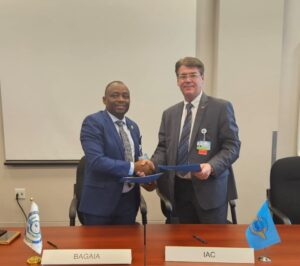
BY OLAPEJU OLUBI
A new chapter has opened in international aviation safety as the Banjul Accord Group Accident Investigation Agency (BAGAIA) and the Interstate Aviation Committee (IAC) signed a key Memorandum of Understanding (MoU) during the 42nd ICAO Assembly in Montreal, Canada.
The historic agreement, sealed on September 25, 2025, marks the first time two Regional Accident Investigation Organizations (RAIOs) have entered into a formal cooperation pact.
The document was signed by BAGAIA Commissioner, Engr. Charles Irikefe Erhueh, and IAC Chairman, Oleg Storchevoy, in what aviation stakeholders are describing as a watershed moment for global safety oversight.
For the two leaders, the message was clear: aviation safety transcends borders, and only through collaboration can the industry reduce risks and raise standards.
“This MoU is a landmark for both Africa and Eurasia. It shows that when it comes to aviation safety, borders should not be barriers. We are stronger when we share expertise, data, and resources,” Erhueh declared shortly after the ceremony.
Storchevoy corroborated, noting that the pact would allow both agencies “to pool our strengths and contribute to a safer global airspace.
Harmonizing our approaches will help ensure that investigations are timely, thorough, and consistent with ICAO standards.”
Far from being symbolic, the agreement lays down a comprehensive framework for cooperation.
It provides for the exchange of technical know-how, specialist equipment, and research opportunities, while creating avenues for joint projects on accident causation and emerging technologies.
Through the sharing of best practices and safety data, both regions are expected to sharpen their preventive capacity and raise investigative standards in line with ICAO provisions.
The pact also shines a spotlight on human capital development, with plans for joint workshops, regional training seminars, and mentorship programs designed to deepen the skills of investigators.
By linking professionals from Africa and Eurasia, the MoU is set to broaden the network of aviation safety expertise and foster stronger ties between investigators, regulators, and civil aviation authorities across continents.
Observers believe that such collaboration will encourage the harmonization of regulations and reporting standards, making cross-border investigations more efficient and their findings more consistent.
Both parties have committed themselves to sharing technical support, providing guidance during investigations, and encouraging cross-participation in training programs.
The agreement is anchored on principles of confidentiality, mutual respect, and independent financial responsibility, with mechanisms for dispute resolution and strict compliance with international data protection protocols.
The MoU takes effect immediately and is open-ended, though it provides flexibility for amendments and voluntary termination with one month’s notice, provided existing obligations are honored.
This adaptability ensures that the pact can evolve with emerging challenges while sustaining the spirit of collaboration that inspired it.
For many in the industry, the agreement is more than just a bilateral arrangement; it is a template for future cooperation among regional safety bodies.
By bringing together the investigative expertise of Africa and Eurasia, the MoU not only enhances oversight but also accelerates the global quest for harmonized aviation safety.
Analysts say it represents the dawn of a new era in which regional agencies see themselves not as isolated entities but as part of an interconnected web working toward safer skies.
As Engineer Erhueh aptly summed it up, “What we have started here is bigger than BAGAIA and IAC. It is about creating a safer sky for everyone, everywhere.”
With this historic pact, the global aviation community takes a decisive step towards deeper collaboration, proving once again that safety is strongest when it is shared.
Olapeju is a journalist and aviation reporter.




